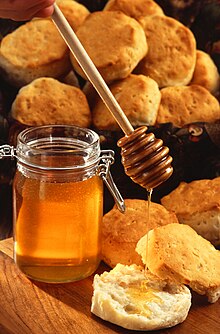Portal:Food
F o o d
A portal dedicated to food and foodways
Introduction


Food is any substance consumed by an organism for nutritional support. Food is usually of plant, animal, or fungal origin and contains essential nutrients such as carbohydrates, fats, proteins, vitamins, or minerals. The substance is ingested by an organism and assimilated by the organism's cells to provide energy, maintain life, or stimulate growth. Different species of animals have different feeding behaviours that satisfy the needs of their metabolisms and have evolved to fill a specific ecological niche within specific geographical contexts.
Omnivorous humans are highly adaptable and have adapted to obtain food in many different ecosystems. Humans generally use cooking to prepare food for consumption. The majority of the food energy required is supplied by the industrial food industry, which produces food through intensive agriculture and distributes it through complex food processing and food distribution systems. This system of conventional agriculture relies heavily on fossil fuels, which means that the food and agricultural systems are one of the major contributors to climate change, accounting for as much as 37% of total greenhouse gas emissions. (Full article...)
Cooking, also known as cookery or professionally as the culinary arts, is the art, science and craft of using heat to make food more palatable, digestible, nutritious, or safe. Cooking techniques and ingredients vary widely, from grilling food over an open fire, to using electric stoves, to baking in various types of ovens, reflecting local conditions. Cooking is an aspect of all human societies and a cultural universal.
Preparing food with heat or fire is an activity unique to humans. Archeological evidence of cooking fires from at least 300,000 years ago exists, but some estimate that humans started cooking up to 2 million years ago.
The expansion of agriculture, commerce, trade, and transportation between civilizations in different regions offered cooks many new ingredients. New inventions and technologies, such as the invention of pottery for holding and boiling of water, expanded cooking techniques. Some modern cooks apply advanced scientific techniques to food preparation to further enhance the flavor of the dish served. (Full article...)
Dinner by Heston Blumenthal is a restaurant in London, England, created by Heston Blumenthal. Opened in January 2011, it received a Michelin star within a year and earned its second in 2014. In April 2014, it was listed fifth on The World's 50 Best Restaurants in Restaurant.
Dinner was initially headed by Ashley Palmer-Watts, formerly the head chef of another Blumenthal restaurant, the Fat Duck. When he left in December 2019, Jon Miles-Bowring became head chef. Menu items are based on historical British dishes, which were researched by food historians and through the British Library. The restaurant's opening drew interest within the industry, and reviews have been positive. Particular dishes have received praise, including the "meat fruit", a chicken liver mousse created to look like a mandarin orange. (Full article...)
Selected article –
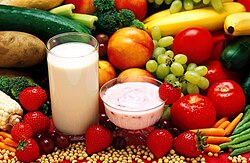
Vegetarianism is the practice of abstaining from the consumption of meat (red meat, poultry, seafood, insects, and the flesh of any other animal). It may also include abstaining from eating all by-products of animal slaughter.
Vegetarianism may be adopted for various reasons. Many people object to eating meat out of respect for sentient animal life. Such ethical motivations have been codified under various religious beliefs as well as animal rights advocacy. Other motivations for vegetarianism are health-related, political, environmental, cultural, aesthetic, economic, taste-related, or relate to other personal preferences. (Full article...)Selected cuisine -
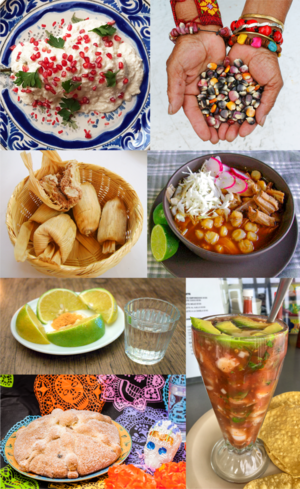
Mexican cuisine consists of the cooking cuisines and traditions of the modern country of Mexico. Its earliest roots lie in Mesoamerican cuisine. Its ingredients and methods begin with the first agricultural communities such as the Olmec and Maya who domesticated maize, created the standard process of nixtamalization, and established their foodways. Successive waves of other Mesoamerican groups brought with them their cooking methods. These included: the Teotihuacanos, Toltec, Huastec, Zapotec, Mixtec, Otomi, Purépecha, Totonac, Mazatec, Mazahua, and Nahua. With the Mexica formation of the multi-ethnic Triple Alliance (Aztec Empire), culinary foodways became infused (Aztec cuisine).
Today's food staples native to the land include corn (maize), turkey, beans, squash, amaranth, chia, avocados, tomatoes, tomatillos, cacao, vanilla, agave, spirulina, sweet potato, cactus, and chili pepper. Its history over the centuries has resulted in regional cuisines based on local conditions, including Baja Med, Chiapas, Veracruz, Oaxacan, and the American cuisines of New Mexican and Tex-Mex. (Full article...)Selected ingredient –
Honey is a sweet and viscous substance made by several species of bees, the best-known of which are honey bees. Honey is made and stored to nourish bee colonies. Bees produce honey by gathering and then refining the sugary secretions of plants (primarily floral nectar) or the secretions of other insects, like the honeydew of aphids. This refinement takes place both within individual bees, through regurgitation and enzymatic activity, and during storage in the hive, through water evaporation that concentrates the honey's sugars until it is thick and viscous.
Honey bees stockpile honey in the hive. Within the hive is a structure made from wax called honeycomb. The honeycomb is made up of hundreds or thousands of hexagonal cells, into which the bees regurgitate honey for storage. Other honey-producing species of bee store the substance in different structures, such as the pots made of wax and resin used by the stingless bee. (Full article...)
Selected recipe –
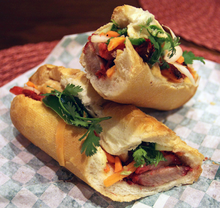
In Vietnamese cuisine, bánh mì or banh mi (/ˈbɑːn miː/, /ˈbæn/; Vietnamese: [ɓǎjŋ̟ mì], 'bread') is a short baguette with thin, crisp crust and a soft, airy texture. It is often split lengthwise and filled with meat and savory ingredients like a submarine sandwich and served as a meal, called bánh mì thịt. Plain bánh mì is also eaten as a staple food.
A typical Vietnamese roll or sandwich is a fusion of meats and vegetables from native Vietnamese cuisine such as chả lụa (Vietnamese sausage), coriander (cilantro), cucumber, pickled carrots, and pickled daikon combined with condiments from French cuisine such as pâté, along with red chili and mayonnaise. However, a variety of popular fillings are used, from xá xíu (Chinese barbecued pork) to even ice cream. In Vietnam, bread rolls and sandwiches are typically eaten for breakfast or as a snack. (Full article...)

Malagasy cuisine encompasses the many diverse culinary traditions of the Indian Ocean island of Madagascar. Foods eaten in Madagascar reflect the influence of Southeast Asian, African, Oceanian, Indian, Chinese and European migrants that have settled on the island since it was first populated by seafarers from Borneo between 100 CE and 500 CE. Rice, the cornerstone of the Malagasy diet, was cultivated alongside tubers and other Southeast Asian and Oceanian staples by these earliest settlers. Their diet was supplemented by foraging and hunting wild game, which contributed to the extinction of the island's bird and mammal megafauna. These food sources were later complemented by beef in the form of zebu introduced into Madagascar by East African migrants arriving around 1,000 CE.
Trade with Arab and Indian merchants and European transatlantic traders further enriched the island's culinary traditions by introducing a wealth of new fruits, vegetables, and seasonings. (Full article...)Selected image –
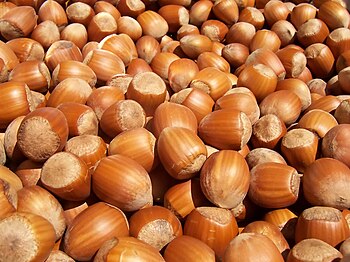
Selected biography –
Alain Ducasse
B. September 13th 1956
Alain Ducasse (French: [alɛ̃ dykas]; born 13 September 1956) is a French-born Monégasque chef. He operates a number of restaurants including Alain Ducasse at The Dorchester which holds three stars (the top rating) in the Michelin Guide. (Full article...)
Did you know (auto-generated) –

- ... that fermented leaves are used to make a meat substitute in Sudan called kawal?
- ... that after her father received hospice care, Connecticut state legislator Claudia Powers introduced bills to include hospice under Medicare?
- ... that the Indianapolis Community Food Access Coalition was created to resolve food deserts in the city of Indianapolis?
- ... that New Zealand editor and journalist Madeleine Chapman, known for fashion label exposés and snack food ranking lists, is a champion javelin thrower?
- ... that by 1967, staff at the Home Office were told not to feed Peta morsels of food as she had become "inordinately fat"?
- ... that Kenneth Lo was called "the foremost expert in Britain on Chinese food"?
More did you know –
Related portals
Food topics
The following are topics relating to food
Categories
Food list articles
- See also: Lists of foods and Category:Lists of drinks
The following are some Food list articles on Wikipedia:

- American cheeses
- Appellation d'Origine Contrôlée cheeses
- Apple cultivars
- Bacon dishes
- Bacon substitutes
- Basil cultivars
- Breads
- Breakfast beverages
- Breakfast cereals
- Breakfast foods
- British cheeses
- Cakes
- Candies
- Cheeses
- Cheese soups
- Christmas dishes (list)
- Cocktails
- Cookies
- Dishes using coconut milk
- Diets
- Doughnut varieties
- Egg dishes
- Fermented soy products
- Food additives
- Food additives (Codex Alimentarius)
- Foods named after people
- French cheeses
- French dishes
- Fried dough foods
- Fruits
- List of hamburgers
- Herbs and spices
- Hors d'oeuvre
- Indian dishes
- Indian snack foods
- Indonesian dishes
- Italian dishes
- Japanese snacks
- Japanese dishes
- Jewish dishes
- Kebabs
- Korean beverages
- Mango cultivars
- Moroccan dishes
- Pasta
- Pastries
- Philippine snack food
- Pies, tarts and flans
- Poppy seed pastries and dishes
- Potato dishes
- Puddings
- Raw fish dishes
- Rice dishes
- Rolled foods
- Sauces
- Seafood
- Seeds
- Sandwiches
- Snack foods
- Soft drinks by country
- Soul foods and dishes
- Soups
- Stews
- Street foods
- Tapas
- Turkish dishes
- Twice-baked foods
- Vegetable oils
- Vegetables
- Vodkas
Things you can do
Related WikiProjects
| Parent project: WikiProject Food and Drink | |
| Child projects: | Task forces: (All inactive) |
|
|
| Related projects: | |
New articles
Rules | Match log | Results page (for watching) | Last updated: 2024-06-03 19:25 (UTC)
Note: The list display can now be customized by each user. See List display personalization for details.
- John Greene (Nurse) (edit | talk | history | links | watch | logs | tools) by Sue8183 (talk · contribs · new pages (1)) started on 2024-06-03, score: 40
- Red Boat (edit | talk | history | links | watch | logs | tools) by Valereee (talk · contribs · new pages (4)) started on 2024-06-02, score: 10
- Agrosuper (edit | talk | history | links | watch | logs | tools) by FrederickEvans (talk · contribs · new pages (27)) started on 2024-06-02, score: 30
- Fowler Ltd. (edit | talk | history | links | watch | logs | tools) by EssNS (talk · contribs · new pages (27)) started on 2024-06-01, score: 10
- Nilla Wafers (edit | talk | history | links | watch | logs | tools) by Voorts (talk · contribs · new pages (46)) started on 2024-05-26, score: 10
- Solari's (edit | talk | history | links | watch | logs | tools) by Nolabob (talk · contribs · new pages (1)) started on 2024-06-01, score: 20
- Nasi katok (edit | talk | history | links | watch | logs | tools) by The Bangsawan (talk · contribs · new pages (13)) started on 2024-06-01, score: 20
- Justin Sterner (edit | talk | history | links | watch | logs | tools) by Muboshgu (talk · contribs · new pages (15)) started on 2024-05-31, score: 10
- Warankasi (edit | talk | history | links | watch | logs | tools) by Wiisstlo (talk · contribs · new pages (5)) started on 2024-05-26, score: 20
- Brennans Bread (edit | talk | history | links | watch | logs | tools) by Gatepainter (talk · contribs · new pages (3)) started on 2024-05-31, score: 20
- Karin-Lis Svarre (edit | talk | history | links | watch | logs | tools) by Ipigott (talk · contribs · new pages (10)) started on 2024-05-31, score: 10
- Indori poha (edit | talk | history | links | watch | logs | tools) by Apocheir (talk · contribs · new pages (5)) started on 2024-05-30, score: 20
- Tanuki (restaurant) (edit | talk | history | links | watch | logs | tools) by Another Believer (talk · contribs · new pages (114)) started on 2024-05-30, score: 10
- Lena Ice Cream (edit | talk | history | links | watch | logs | tools) by Syazwi Irfan (talk · contribs · new pages (3)) started on 2024-05-23, score: 30
- Ko Myeong-seok (edit | talk | history | links | watch | logs | tools) by Explicit (talk · contribs · new pages (4)) started on 2024-05-30, score: 10
- Savanyúság (edit | talk | history | links | watch | logs | tools) by Konnor Martin (talk · contribs · new pages (1)) started on 2024-05-29, score: 10
- Laal maas (edit | talk | history | links | watch | logs | tools) by SafariScribe (talk · contribs · new pages (149)) started on 2024-05-29, score: 30
- Furrundu (edit | talk | history | links | watch | logs | tools) by BaduFerreira (talk · contribs · new pages (3)) started on 2024-05-29, score: 50
- Hyman's Seafood (edit | talk | history | links | watch | logs | tools) by DMVHistorian (talk · contribs · new pages (5)) started on 2024-05-28, score: 10
- Pickup Coffee (edit | talk | history | links | watch | logs | tools) by Hariboneagle927 (talk · contribs · new pages (22)) started on 2024-05-28, score: 20
- Geoffrey Hawtin (edit | talk | history | links | watch | logs | tools) by Chromista (talk · contribs · new pages (1)) started on 2024-05-28, score: 10
- Palani Panchamirtham (edit | talk | history | links | watch | logs | tools) by Magentic Manifestations (talk · contribs · new pages (14)) started on 2024-05-27, score: 10
- Erismatopterus (edit | talk | history | links | watch | logs | tools) by Kevmin (talk · contribs · new pages (20)) started on 2024-05-27, score: 10
- Saskatoon berry pie (edit | talk | history | links | watch | logs | tools) by Reywas92 (talk · contribs · new pages (2)) started on 2024-05-27, score: 30
- Zus Coffee (edit | talk | history | links | watch | logs | tools) by Hariboneagle927 (talk · contribs · new pages (22)) started on 2024-05-27, score: 20
- Space Cola Wars (edit | talk | history | links | watch | logs | tools) by Artem.G (talk · contribs · new pages (14)) started on 2024-05-27, score: 10
- Conchas de Piedra (edit | talk | history | links | watch | logs | tools) by Another Believer (talk · contribs · new pages (114)) started on 2024-05-27, score: 10
- Torta Balcarce (edit | talk | history | links | watch | logs | tools) by Murmuring Rock (talk · contribs · new pages (4)) started on 2024-05-25, score: 20
- Bilal Yalcinkaya (edit | talk | history | links | watch | logs | tools) by Das osmnezz (talk · contribs · new pages (39)) started on 2024-05-23, score: 10
- Andok's (edit | talk | history | links | watch | logs | tools) by Karich28 (talk · contribs · new pages (4)) started on 2024-05-22, score: 20
- Doe Donuts (edit | talk | history | links | watch | logs | tools) by Another Believer (talk · contribs · new pages (114)) started on 2024-05-23, score: 10
- I, the Executioner (2024 film) (edit | talk | history | links | watch | logs | tools) by Οἶδα (talk · contribs · new pages (62)) started on 2024-05-21, score: 10
- Virginia Sole-Smith (edit | talk | history | links | watch | logs | tools) by Marquardtika (talk · contribs · new pages (1)) started on 2024-05-22, score: 10
- Lohusa şerbeti (edit | talk | history | links | watch | logs | tools) by Macrakis (talk · contribs · new pages (8)) started on 2024-05-22, score: 30
- I, the Executioner (edit | talk | history | links | watch | logs | tools) by Οἶδα (talk · contribs · new pages (62)) started on 2024-05-21, score: 10
- Paul Parkman (edit | talk | history | links | watch | logs | tools) by Thriley (talk · contribs · new pages (70)) started on 2024-05-21, score: 10
- Two Roosters Ice Cream (edit | talk | history | links | watch | logs | tools) by Johnson524 (talk · contribs · new pages (3)) started on 2024-05-21, score: 10
- There Be Monsters (edit | talk | history | links | watch | logs | tools) by Another Believer (talk · contribs · new pages (114)) started on 2024-05-21, score: 10
- Chinir saaj (edit | talk | history | links | watch | logs | tools) by Moriwen (talk · contribs · new pages (264)) started on 2024-05-21, score: 30
- Doogh (edit | talk | history | links | watch | logs | tools) by MuhammedBenShalom (talk · contribs · new pages (1)) started on 2024-05-21, score: 20
- Sata physic gardens (edit | talk | history | links | watch | logs | tools) by MChew (talk · contribs · new pages (16)) started on 2024-05-21, score: 10
- Nam Dae-sik (edit | talk | history | links | watch | logs | tools) by Das osmnezz (talk · contribs · new pages (39)) started on 2024-05-20, score: 10
- Le Chique (edit | talk | history | links | watch | logs | tools) by Another Believer (talk · contribs · new pages (114)) started on 2024-05-20, score: 10
- Pao Alentejano (edit | talk | history | links | watch | logs | tools) by Valereee (talk · contribs · new pages (4)) started on 2024-05-20, score: 10
- Sir Grapefellow and Baron von Redberry (edit | talk | history | links | watch | logs | tools) by Retrosunshine2006 (talk · contribs · new pages (1)) started on 2024-05-20, score: 20
- Khanom Med Khanoon (edit | talk | history | links | watch | logs | tools) by Quantplinus (talk · contribs · new pages (0)) started on 2024-05-18, score: 10
Associated Wikimedia
The following Wikimedia Foundation sister projects provide more on this subject:
-
Commons
Free media repository -
Wikibooks
Free textbooks and manuals -
Wikidata
Free knowledge base -
Wikinews
Free-content news -
Wikiquote
Collection of quotations -
Wikisource
Free-content library -
Wikiversity
Free learning tools -
Wiktionary
Dictionary and thesaurus























